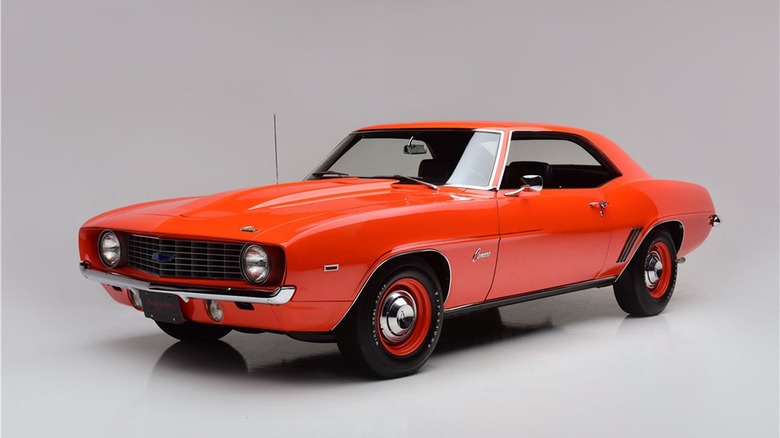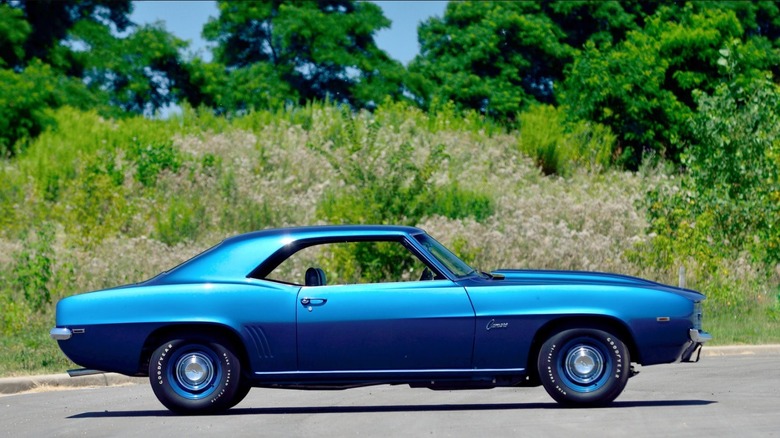Here's How Fast The 1969 COPO Camaro Really Is
No, not "copa" (as in Copacabana) or even C3PO. The acronym COPO stands for Central Office Production Order, a decidedly unglamorous designation that isn't nearly as cool as a protocol droid that knows seven million forms of communication. Still, the 1969 Chevrolet COPO Camaro ZL1 is one of the rarest Camaros the company ever made, making it a highly desired collector car.
The legend of the COPO Camaro begins in the late 1960s with Vince Piggins, who worked for Chevy for some 30 years. Piggins never went to school to become an engineer, but knew more about cars and engines than most of his co-workers who did. During his time at Chevy, Piggins was involved with several "high-performance programs," and is widely heralded as the "father" of the Z/28.
At the time, Chevy used an internal vehicle ordering system that let its dealers place fleet orders (think police cars, taxi cabs, trucking companies, etc.) for customers with vehicles that needed special equipment, features, or color schemes. Piggins took that system and began using it to obtain hopped-up car parts and systems, which he, in turn, passed on to dealers and customers to do with as they saw fit. All the while never raising any internal red flags at the corporate level.
Enter Fred Gibb, a Chevy car dealer in LaHarpe, Illinois, who also happened to be a drag racer. According to Chevrolet, Gibb figured that if Piggins could do it with parts, why not do it for a whole car? So, in 1968 he used the COPO system to order fifty (50) Novas with the L78 396-ci big-block engines that, before then, were only available in Chevy's full-size cars.
Gibb and Piggins worked Chevy's system
By all accounts, Gibb was looking for a way to one-up his competition on the NHRA drag strip. But first, he had to find a way to get around the association's homologation requirement that an automaker builds at least 50 cars before it could be used on the circuit. Meanwhile, GM had an internal decree that all passenger cars smaller than full-sized sedans couldn't have engines larger than 400 cubic inches. What to do?
In 1969, Gibb tried something audacious and used COPO to order Camaros with the internal 9560 package designation, which included a ZL1 427-ci big aluminum block (and heads) V8 engine under the hood — the same one used in NASCAR. It was about 100 pounds lighter than the standard Camaro 396 engine and definitely more powerful, "officially" kicking out 430 horsepower at 5,200 rpm. However, according to some, it could generate 550 horsepower at 6,500 rpm (via Chevrolet) when appropriately tuned. Gibb's order was approved by none other than Chevy's product manager, Vince Piggins. The car was wholly street-legal and, even more bizarrely, came with a 5-year/50,000-mile warranty.
Details are hazy on exactly how many COPO Camaros Gibb ordered. According to Chevy, he ordered 13 for himself, plus 37 more to trade off or sell to other dealers. Other accounts say he actually only took possession of 30, spending some $216,000 (not including tax) of his own money on the "bet" that he could offload the rest. After selling only 13 of them, Gibb faced potential bankruptcy and convinced Chevy to move the rest to other dealers in the network (via Barret-Jackson).
COPO Camaros are both fast and furious
What is certain is only 69 of the COPO 9560 ZL1 Camaros were built (via Chevrolet), with somewhere between 20 and possibly "more than half" (via Street Muscle Magazine) racing in the NHRA Super Stock series. In a 2016 Mecum auction, factory No. 18 sold for $600,000, factory No. 59 sold at a Barret-Jackson auction for $770,000 in 2017, while No. 27 (previously owned by baseball legend Reggie Jackson) "only" sold $159,500. There appear to be four others currently up for sale as well.
Supercars.net says it could do 0 – 60 mph in 5.3 seconds, and run the quarter mile in 13.16 seconds at a top speed of 125 mph. If tuned up further with slicks added, it could do the quarter mile in the "mid 11s at roughly 120 mph" (via Street Muscle Magazine).
Remember that this 9560 Camaro is different from the very similar "Yenko" COPO Camaro (package 9561) made the same year. The 9561 came with different front springs, an ignition system, and a 425 horsepower iron-block L72 engine (via Chevrolet). And that doesn't count the ZL1 engine they dropped into the COPO Corvettes. But that's a story for another time.
With all these COPO Camaros bopping around, maybe Barry Manilow can pen a new version of his song and call it, CopoCamaro.

